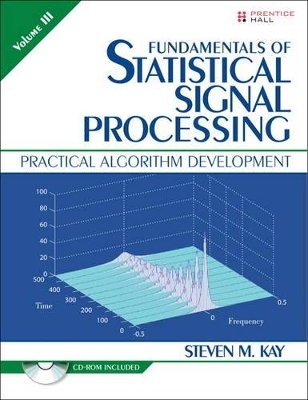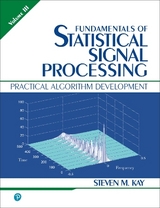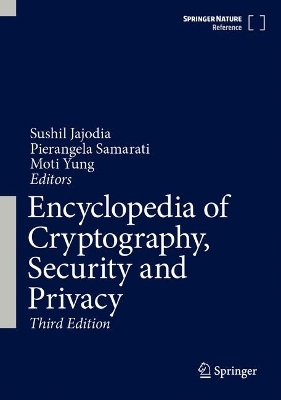
Fundamentals of Statistical Signal Processing, Volume III
Prentice Hall
978-0-13-280803-3 (ISBN)
- Titel erscheint in neuer Auflage
- Artikel merken
In Fundamentals of Statistical Signal Processing, Volume III: Practical Algorithm Development, author Steven M. Kay shows how to convert theories of statistical signal processing estimation and detection into software algorithms that can be implemented on digital computers. This final volume of Kay’s three-volume guide builds on the comprehensive theoretical coverage in the first two volumes. Here, Kay helps readers develop strong intuition and expertise in designing well-performing algorithms that solve real-world problems.
Kay begins by reviewing methodologies for developing signal processing algorithms, including mathematical modeling, computer simulation, and performance evaluation. He links concepts to practice by presenting useful analytical results and implementations for design, evaluation, and testing. Next, he highlights specific algorithms that have “stood the test of time,” offers realistic examples from several key application areas, and introduces useful extensions. Finally, he guides readers through translating mathematical algorithms into MATLAB® code and verifying solutions.
Topics covered include
Step by step approach to the design of algorithms
Comparing and choosing signal and noise models
Performance evaluation, metrics, tradeoffs, testing, and documentation
Optimal approaches using the “big theorems”
Algorithms for estimation, detection, and spectral estimation
Complete case studies: Radar Doppler center frequency estimation, magnetic signal detection, and heart rate monitoring
Exercises are presented throughout, with full solutions, and executable MATLAB code that implements all the algorithms, is provided on the accompanying CD.
This new volume is invaluable to engineers, scientists, and advanced students in every discipline that relies on signal processing; researchers will especially appreciate its timely overview of the state of the practical art. Volume III complements Dr. Kay’s Fundamentals of Statistical Signal Processing, Volume I: Estimation Theory (Prentice Hall, 1993; ISBN-13: 978-0-13-345711-7), and Volume II: Detection Theory (Prentice Hall, 1998; ISBN-13: 978-0-13-504135-2).
Steven M. Kay is one of the world’s leading experts in statistical signal processing. Currently Professor of Electrical Engineering at the University of Rhode Island, Kingston, he has consulted for numerous industrial concerns, the Air Force, Army, and Navy, and has taught short courses to scientists and engineers at NASA and the CIA. Dr. Kay is a Fellow of the IEEE, and a member of Tau Beta Pi, and Sigma Xi and Phi Kappa Phi. He has received the Education Award for “outstanding contributions in education and in writing scholarly book and texts…” from the IEEE Signal Processing society and has been listed as among the 250 most cited researchers in the world in engineering.
Preface xiii About the Author xvii
Part I: Methodology and General Approaches 1
Chapter 1: Introduction 3
1.1 Motivation and Purpose 3
1.2 Core Algorithms 4
1.3 Easy, Hard, and Impossible Problems 5
1.4 Increasing Your Odds for Success–Enhance Your Intuition 11
1.5 Application Areas 13
1.6 Notes to the Reader 14
1.7 Lessons Learned 15
References 16
1A Solutions to Exercises 19
Chapter 2: Methodology for Algorithm Design 23
2.1 Introduction 23
2.2 General Approach 23
2.3 Example of Signal Processing Algorithm Design 31
2.4 Lessons Learned 47
References 48
2A Derivation of Doppler Effect 49
2B Solutions to Exercises 53
Chapter 3: Mathematical Modeling of Signals 55
3.1 Introduction 55
3.2 The Hierarchy of Signal Models 57
3.3 Linear vs. Nonlinear Deterministic Signal Models 61
3.4 Deterministic Signals with Known Parameters (Type 1) 62
3.5 Deterministic Signals with Unknown Parameters (Type 2) 68
3.6 Random Signals with Known PDF (Type 3) 77
3.7 Random Signals with PDF Having Unknown Parameters 83
3.8 Lessons Learned 83
References 83
3A Solutions to Exercises 85
Chapter 4: Mathematical Modeling of Noise 89
4.1 Introduction 89
4.2 General Noise Models 90
4.3 White Gaussian Noise 93
4.4 Colored Gaussian Noise 94
4.5 General Gaussian Noise 102
4.6 IID NonGaussian Noise 108
4.7 Randomly Phased Sinusoids 113
4.8 Lessons Learned 114
References 115
4A Random Process Concepts and Formulas 117
4B Gaussian Random Processes 119
4C Geometrical Interpretation of AR 121
4D Solutions to Exercises 123
Chapter 5: Signal Model Selection 129
5.1 Introduction 129
5.2 Signal Modeling 130
5.3 An Example 131
5.4 Estimation of Parameters 136
5.5 Model Order Selection 138
5.6 Lessons Learned 142
References 143
5A Solutions to Exercises 145
Chapter 6: Noise Model Selection 149
6.1 Introduction 149
6.2 Noise Modeling 150
6.3 An Example 152
6.4 Estimation of Noise Characteristics 161
6.5 Model Order Selection 176
6.6 Lessons Learned 177
References 178
6A Confidence Intervals 179
6B Solutions to Exercises 183
Chapter 7: Performance Evaluation, Testing, and Documentation 189
7.1 Introduction 189
7.2 Why Use a Computer Simulation Evaluation? 189
7.3 Statistically Meaningful Performance Metrics 190
7.4 Performance Bounds 202
7.5 Exact versus Asymptotic Performance 204
7.6 Sensitivity 206
7.7 Valid Performance Comparisons 207
7.8 Performance/Complexity Tradeoffs 209
7.9 Algorithm Software Development 210
7.10 Algorithm Documentation 214
7.11 Lessons Learned 215
References 216
7A A Checklist of Information to Be Included in Algorithm Description Document 217
7B Example of Algorithm Description Document 219
7C Solutions to Exercises 231
Chapter 8: Optimal Approaches Using the Big Theorems 235
8.1 Introduction 235
8.2 The Big Theorems 237
8.3 Optimal Algorithms for the Linear Model 251
8.4 Using the Theorems to Derive a New Result 255
8.5 Practically Optimal Approaches 257
8.6 Lessons Learned 261
References 262
8A Some Insights into Parameter Estimation 263
8B Solutions to Exercises 267
Part II: Specific Algorithms 271
Chapter 9: Algorithms for Estimation 273
9.1 Introduction 273
9.2 Extracting Signal Information 274
9.3 Enhancing Signals Corrupted by Noise/Interference 299
References 308
9A Solutions to Exercises 311
Chapter 10: Algorithms for Detection 313
10.1 Introduction 313
10.2 Signal with Known Form (Known Signal) 315
10.3 Signal with Unknown Form (Random Signals) 322
10.4 Signal with Unknown Parameters 326
References 334
10A Solutions to Exercises 337
Chapter 11: Spectral Estimation 339
11.1 Introduction 339
11.2 Nonparametric (Fourier) Methods 340
11.3 Parametric (Model-Based) Spectral Analysis 348
11.4 Time-Varying Power Spectral Densities 356
References 357
11A Fourier Spectral Analysis and Filtering 359
11B The Issue of Zero Padding and Resolution 361
11C Solutions to Exercises 363
Part III: Real-World Extensions 365
Chapter 12: Complex Data Extensions 367
12.1 Introduction 367
12.2 Complex Signals 371
12.3 Complex Noise 372
12.4 Complex Least Squares and the Linear Model 378
12.5 Algorithm Extensions for Complex Data 379
12.6 Other Extensions 395
12.7 Lessons Learned 396
References 396
12A Solutions to Exercises 399
Part IV: Real-World Applications 403
Chapter 13: Case Studies - Estimation Problem 405
13.1 Introduction 405
13.2 Estimation Problem - Radar Doppler Center Frequency 406
13.3 Lessons Learned 416
References 417
13A 3 dB Bandwidth of AR PSD 419
13B Solutions to Exercises 421
Chapter 14: Case Studies - Detection Problem 423
14.1 Introduction 423
14.2 Detection Problem–Magnetic Signal Detection 423
14.3 Lessons Learned 439
References 439
14A Solutions to Exercises 441
Chapter 15: Case Studies - Spectral Estimation Problem 443
15.1 Introduction 443
15.2 Extracting the Muscle Noise 446
15.3 Spectral Analysis of Muscle Noise 449
15.4 Enhancing the ECG Waveform 451
15.5 Lessons Learned 453
References 453
15A Solutions to Exercises 455
Appendix A: Glossary of Symbols and Abbreviations 457
A.1 Symbols 457
A.2 Abbreviations 459
Appendix B: Brief Introduction to MATLAB 461
B.1 Overview of MATLAB 461
B.2 Plotting in MATLAB 464
Appendix C: Description of CD Contents 467
C.1 CD Folders 467
C.2 Utility Files Description 467
Index 471
| Erscheint lt. Verlag | 4.4.2013 |
|---|---|
| Verlagsort | Upper Saddle River |
| Sprache | englisch |
| Maße | 183 x 236 mm |
| Gewicht | 940 g |
| Themenwelt | Informatik ► Theorie / Studium ► Algorithmen |
| Technik ► Nachrichtentechnik | |
| ISBN-10 | 0-13-280803-X / 013280803X |
| ISBN-13 | 978-0-13-280803-3 / 9780132808033 |
| Zustand | Neuware |
| Informationen gemäß Produktsicherheitsverordnung (GPSR) | |
| Haben Sie eine Frage zum Produkt? |
aus dem Bereich

